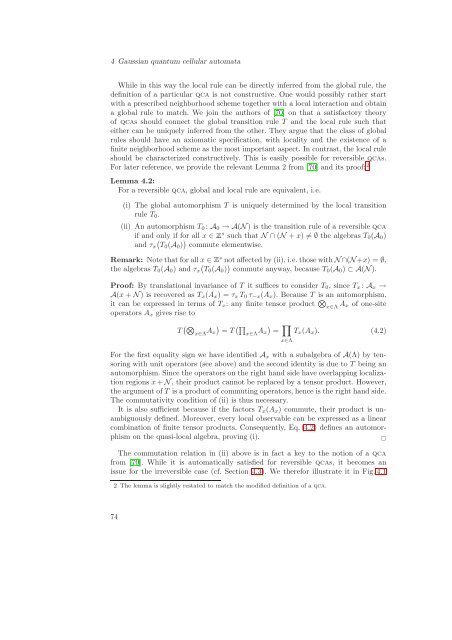Quantum Information Theory with Gaussian Systems
Quantum Information Theory with Gaussian Systems
Quantum Information Theory with Gaussian Systems
Create successful ePaper yourself
Turn your PDF publications into a flip-book with our unique Google optimized e-Paper software.
4 <strong>Gaussian</strong> quantum cellular automata<br />
While in this way the local rule can be directly inferred from the global rule, the<br />
definition of a particular qca is not constructive. One would possibly rather start<br />
<strong>with</strong> a prescribed neighborhood scheme together <strong>with</strong> a local interaction and obtain<br />
a global rule to match. We join the authors of [70] on that a satisfactory theory<br />
of qcas should connect the global transition rule T and the local rule such that<br />
either can be uniquely inferred from the other. They argue that the class of global<br />
rules should have an axiomatic specification, <strong>with</strong> locality and the existence of a<br />
finite neighborhood scheme as the most important aspect. In contrast, the local rule<br />
should be characterized constructively. This is easily possible for reversible qcas.<br />
For later reference, we provide the relevant Lemma 2 from [70] and its proof: 2<br />
Lemma 4.2:<br />
For a reversible qca, global and local rule are equivalent, i.e.<br />
(i) The global automorphism T is uniquely determined by the local transition<br />
rule T0.<br />
(ii) An automorphism T0: A0 → A(N) is the transition rule of a reversible qca<br />
if and only if for all x ∈s<br />
such that N ∩ (N + x) = ∅ the algebras T0(A0)<br />
and τx T0(A0) commute elementwise.<br />
Remark: Note that for all x ∈s<br />
not affected by (ii), i.e. those <strong>with</strong> N ∩(N+x) = ∅,<br />
the algebras T0(A0) and τx T0(A0) commute anyway, because T0(A0) ⊂ A(N).<br />
Proof: By translational invariance of T it suffices to consider T0, since Tx: Ax →<br />
A(x + N) is recovered as Tx(Ax) = τx T0 τ−x(Ax). Because T is an automorphism,<br />
it can be expressed in terms of Tx: any finite tensor product <br />
x∈Λ Ax of one-site<br />
operators Ax gives rise to<br />
T <br />
x∈ΛAx <br />
= T x∈ΛAx <br />
= Tx(Ax). (4.2)<br />
x∈Λ<br />
For the first equality sign we have identified Ax <strong>with</strong> a subalgebra of A(Λ) by tensoring<br />
<strong>with</strong> unit operators (see above) and the second identity is due to T being an<br />
automorphism. Since the operators on the right hand side have overlapping localization<br />
regions x + N, their product cannot be replaced by a tensor product. However,<br />
the argument of T is a product of commuting operators, hence is the right hand side.<br />
The commutativity condition of (ii) is thus necessary.<br />
It is also sufficient because if the factors Tx(Ax) commute, their product is unambiguously<br />
defined. Moreover, every local observable can be expressed as a linear<br />
combination of finite tensor products. Consequently, Eq.(4.2) defines an automorphism<br />
on the quasi-local algebra, proving (i). <br />
The commutation relation in (ii) above is in fact a key to the notion of a qca<br />
from [70]. While it is automatically satisfied for reversible qcas, it becomes an<br />
issue for the irreversible case (cf. Section 4.3). We therefor illustrate it in Fig. 4.1<br />
2 The lemma is slightly restated to match the modified definition of a qca.<br />
74
















